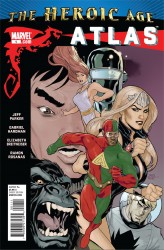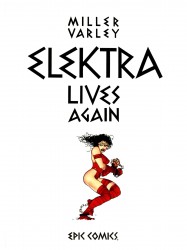
Is it time to leave the past behind?
September 3rd, 2010 Posted by david brothersBrian Michael Bendis has been writing Avengers-related books since 2004. Across three series, six years, and something like 100 issues, Bendis has been the main architect for the non-X-Men part of the Marvel Universe. A stray thought flickered across my brain earlier tonight and it kind of bothered me. I’ve read most of Bendis’s Avengers, and liked some of it, but this thought just wouldn’t go away. “How many villains did Bendis invent for the Avengers to fight?”
The answer is one. In The Collective, the third collection I believe, he introduced Michael Pointer, a man who was possessed by mutant powers and was also maybe Xorn? Other than that, everything else Bendis introduced is a new, or mediocre, spin on an old idea. Hawkeye becomes Ronin, skrulls shapeshift into heroes, and a Spider-Man villain causes problems. Luke Cage and Jessica Jones having a daughter should maybe count as being a new idea, which raises the total to two.
That’s a one new idea every fifty issues average.
The biggest takeaway from Darwyn Cooke’s interview the other day is about ideas and originality. His point about changing characters to pander to the audience is a good one, and sparked some interesting (and asinine) discussion in the comments. It’s also an argument I keep coming back to when looking at cape comics and trying to decide what’s worth buying. I think that legacies, and the kind of worshipful attention to continuity that legacies imply, is both interesting and odious.
Okay. For whatever reason, there are stories that matter more than other stories in the Big Two. They advance the stories of characters people are about, etc etc. You already know this, I’ve already called it dumb, and veered dangerously close into whiny “Why don’t people like what I like” territory at the same time. But it is what it is, and that is what sells. When you get a chance to play in the side of the Shared Universe playground, when you get to the point where you’re Geoff Johns or Brian Bendis or Jonathan Hickman or whoever, you want to 1) have your stories matter and 2) play with all the toys.
That’s the fun of shared universes. You get to contribute to this amazing tapestry that existed decades before you were born. You can reference all of your favorite stories and hopefully create new favorites for others. If you’re open to it, you can even create some new concepts or spin an old character off into a legacy character, thereby staking out your own claim on the tapestry.
If you’re coming into comics now, you’re coming into an industry with a history. Fans expect to see Dr. Doom in Fantastic Four, and more than that, they expect to see your take on Dr. Doom. He haunts every run on the book in a way that Paste Pot Pete doesn’t. This is true of the Joker and Batman, Lex Luthor and Superman, and Hypno Hustler and Spider-Man. There’s a reason that Grant Morrison threw Magneto into New X-Men the way he did. You have to use these characters because that’s who these heroes fight. This is established behavior.
The Avengers fight Avengers villains. Bendis’s run seems to show that this is how it works, isn’t it? Even the story about the new villain ended up being about Magneto in the end. But the breakout, Sentry origin, Civil War, Secret Invasion… they didn’t actually introduce much, did they? Skrulls invade, heroes beef, and the latest verse sounds a whole lot like the verse that came before it, doesn’t it?
I think that, past a certain point, telling new stories with old characters is going to end up being diminishing returns. If the Avengers only fight Avengers villains, where’s the new blood going to come from? Who are the next Avengers villains going to fight? Is there a good reason for the Fantastic Four to fight Dr. Doom once every couple of years beyond “Well, that’s how it is?”
I think legacy characters often have the same result. You trade a lot in favor of a little. Two simple, and fantastic, examples: Renee Montoya and Crispus Allen were two stand-out characters from Gotham Central, which was probably the best bat-related book on the stands at the time. Montoya self-destructed, Allen died, and the series ended. Later, Renee becomes the new Question and Crispus becomes the new, goateed Spectre.
We traded four characters for two, and I don’t think that was a fair trade at all. Montoya and Allen both had very interesting roles to play, and their new superheroic identities often don’t seem to have much to do with that. Allen was an upright and moral man, and his role as part of the Spectre is apparently to go “Hey hold on now do we have to turn this guy into an elephant and sell his tusks on the black market? That’s ironic, yes, but it’s also cruel. Also I miss my family.” Montoya had turned boozing into an art, and while her climb back to sobriety was a pretty good read, none of it actually necessitated her being The Question to get it done.
Would Montoya becoming a PI appreciably change any of her stories? I don’t think they would. The Question is pretty low-tech as a concept, so all you really need is a hat and a trenchcoat. Why not keep both? Why use Renee to revive The Question trademark? Why use The Question to prop up Renee?
I’ve seen people argue that it’s better to have these characters in stories than not, so better that they change form than languish in obscurity, but I don’t buy that line of reasoning at all. I think that the value we get from having Montoya or Allen showing up once or twice a year these days isn’t worth the loss of the four characters that make them up. If characters aren’t appearing, then no one has stories to tell with them. Write stories with them or don’t write stories with them, rather than playing Dr. Frankenstein.
100 or so issues, one brand new villain. Four characters reduced to two, and the two that remain are decades old. Do you see how ridiculous that looks? That’s what happens when you have this kind of reverence for your shared universe. It’s stifling, isn’t it? If you don’t introduce new concepts and keep bowing down to the altar of old folks’ comics, all you’re going to make is old folks’ comics. It’s like if every third James Bond movie featured him fighting Jaws, or if Spike Lee kept doing movies about Radio Raheem.
A good story trumps everything, obviously, but the more I think about legacy characters, the more I feel like it’s time to jettison that entire idea. No New Legacies. We’re stuck with the ones we have, obviously, but why did Jaime Reyes have to be a Blue Beetle? Was Jason Rusch as Firestorm a choice that was worth it in the end? What if he were a different, all-new character instead? Why wasn’t he an all-new character? Why did he have to be an old character in new clothes? I know that if I never see Black (Established Hero) again, it’ll be too soon. I understand why it happens, both from a charitable view (Someone wants to add to the tapestry and had a good idea how to do it) and a cynical view (they want to trick colored folks into reading their comics by ticking a box on the Diversity Checklist), but I would absolutely rather see someone all-new, maybe with connections to the old character, under a brand new name, rather than a replacement.
Should you have to make thin connections to established heroes to make your character a minor success? I feel like if the Big Two can’t support new concepts, then the Big Two are broken. Is that unfair?















